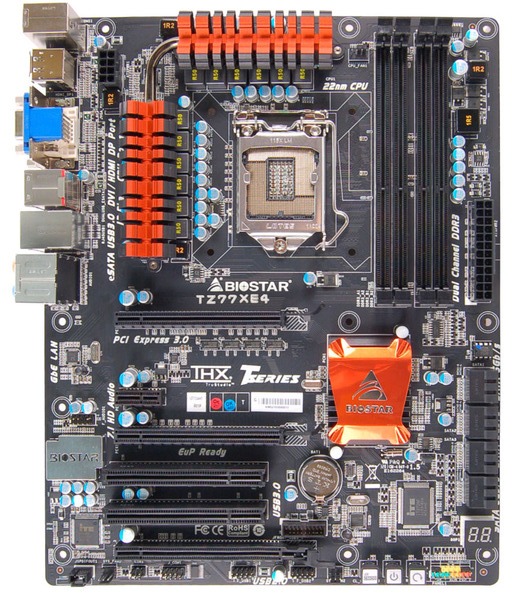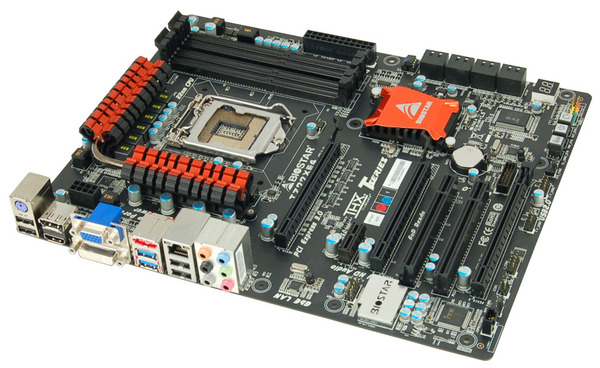Intel Z77 Panther Point Chipset and Motherboard Preview – ASRock, ASUS, Gigabyte, MSI, ECS and Biostar
by Ian Cutress on April 8, 2012 12:00 AM EST- Posted in
- Motherboards
- Intel
- Biostar
- MSI
- Gigabyte
- ASRock
- Asus
- Ivy Bridge
- ECS
- Z77
Biostar TZ77XE4—Visual Inspection
With memories of Biostar fresh in my mind from the 990FX roundup, I have another chance to tackle a motherboard from them. This one comes in at more of a premium than the other—at an MSRP of $169 it is not the cheapest board this time. However, it does seem to have learned some lessons with the PCIe layout at least, but in terms of features we are perhaps a bit lacking.
Biostar have characteristically been black and orange, and we see it here again on their top Z77 model, the TZ77XE4. Power delivery is essentially a 10+2 (CPU/iGPU) system with large brightly colored heatsinks to remove heat, both connected via a heatpipe. These heatsinks are set a little away from the Intel designated socket area, though the memory banks are right up against the boundary—with only two sticks of memory in the board there will be enough room for most of the beefiest air coolers.
In terms of fan headers, Biostar have unfortunately put much effort in here, with only three to play with—a 4-pin CPU fan header to the top right of the socket, and two 3-pin at the south end of the board. Anyone requiring headers for fans will have to resort to providing their own fan control.

Along the right hand side, apart from the 24-pin power connector, we have a series of eight SATA ports—two SATA 6 Gbps from the PCH, four SATA 3 Gbps also from the PCH, and another two SATA 6 Gbps from an ASMedia controller. These are unfortunately not color coded, meaning users will have to double check every time that the SATA cable is going into the port as intended. Below these, we have a two-digit debug display for error reporting.
The chipset heatsink sports the bright orange Biostar color, but is rather small which could lead to it being warm to the touch. On the south side of the board, we are not exactly bursting with headers—aside from the fans, we have front panel headers, a pair of USB 2.0 headers, and power/reset/clear CMOS buttons. These buttons are all similar and next to each other, so I can just see myself accidentally pressing the wrong one from time to time. It is also important to note the location of a USB 3.0 header, just above the third full-length PCIe slot. This is a rather awkward place, and cements its use primarily for rear facing adaptors (as long as there is nothing in the PCI slot beside it).

The PCIe layout is better than previous iterations, featuring an x16 (x8 in dual-GPU), x1, x8, PCI, PCI and Gen 2.0 x4. This leaves a space between GPUs, and a spare x1, PCI and x4 when dual GPUs are being used. Note we do not have a molex connector here, suggesting that Biostar are happy with the power delivery when the PCIe slots are in use.

For back panel functionality, we have a PS2 keyboard port, two USB 2.0 ports (black), DisplayPort, HDMI, D-Sub, DVI-I, eSATA, two USB 3.0 (blue), gigabit Ethernet, two more USB 2.0 (black), and audio jacks. I should stress that even though there is a DVI-I on the back panel, it does not accept analog signals by adaptor.
Board Features
| Biostar TZ77XE4 | |
| Size | ATX |
| CPU Interface | LGA-1155 |
| Chipset | Intel Z77 |
| Power Delivery | 10 + 2 + 1 + 2 (CPU/GPU/VCCIO/Memory) |
| Memory Slots |
Four DDR3 DIMM slots supporting up to 32 GB Up to Dual Channel, 1066-2600 MHz |
| Video Outputs | DisplayPort, HDMI, DVI-D, D-Sub |
| Onboard LAN | Realtek 8111E |
| Onboard Audio | Realtek ALC898 |
| Expansion Slots |
2 x PCIe x16 Gen3 (x16, x8/8) 1 x PCIe x16 Gen2 (x4) 1 x PCIe x1 Gen2 2 x PCI |
| Onboard SATA/RAID |
2 x SATA 6 Gbps (PCH), Support for RAID 0, 1, 5, 10 4 x SATA 3 Gbps (PCH), Support for RAID 0, 1, 5, 10 2 x SATA 6 Gbps (ASMedia Controller) 1 x eSATA 3 Gbps |
| USB |
4 USB 3.0 ports (2 back panel, 2 from headers) 8 USB 2.0 ports (4 back panel, 4 from headers) |
| Onboard |
4 x SATA 6 Gbps 4 x SATA 3 Gbps 1 x USB 3.0 Header 2 x USB 2.0 Header 3 x Fan Headers 1 x CIR Header 1 x SPDIF Output Header 1 x Front Panel Audio Header |
| Power Connectors |
1 x 24-pin ATX connector 1 x 8-pin 12V connector |
| Fan Headers |
1 x CPU Fan Header (4-pin) 2 x SYS Fan Header (3-pin) |
| IO Panel |
1 x PS/2 Keyboard Port 1 x eSATA 2 x USB 3.0 4 x USB 2.0 1 x DisplayPort 1 x HDMI 1 x DVI-D 1 x D-Sub 1 x Gigabit Ethernet Audio Jacks |
| Warranty Period | 3 years from date of sale |
| Product Page | Link |
Aside from the extra SATA controller, PCI slots, Power/Reset buttons and the use of all four display outputs, there's nothing much 'extra' that Biostar have put on the board which isn't already in the default chipset. This could perhaps be their downfall when it comes to conclusions after testing.










145 Comments
View All Comments
t4murphy - Wednesday, April 18, 2012 - link
That was a good cpu for me before I went to the 920. I still ran MS FS9 with good results along with my GTX 8800. Im not laughing:)rocknrob - Thursday, April 12, 2012 - link
I had a 920 X58 setup and decided to rebuild to an i7 2700K Z68. So far I've regretted the whole thing. I'm going to pick up one of these ASUS Z77 Deluxe boards but I don't think it's going to make a big difference.The X58's/i7's were rock solid and performance monsters. I honestly see very little in terms of performance gains. Supposedly Ive Bridge processors are only going to give you about 15% to 20% increase in performance. If that's the case I think I'm going to stick with the 2700K until the next architecture change.
457R4LDR34DKN07 - Sunday, April 8, 2012 - link
you need to get a asus P8Z77-I DELUXE review.Mitxplease - Sunday, April 8, 2012 - link
Hells yes.GreenEnergy - Sunday, April 8, 2012 - link
I only found one (tiny) review sofar:http://vr-zone.com/articles/first-look-asus-p8z77-...
457R4LDR34DKN07 - Wednesday, April 11, 2012 - link
I actually would like a comparison with ZOTAC Z77-ITX WiFi, as I'm leaning toward the zotac mobo due to the msata compatibility by removing the wifi/bt module.ViperV990 - Sunday, April 8, 2012 - link
Does the Virtu MVP stuff work with an Eyefinity or NV Surround setup?martinw89 - Sunday, April 8, 2012 - link
I'm very curious about this too. On page two, Ian says "Within the hybrid system, the integrated GPU takes over two of the tasks for the GPU – snooping for required frames, and display output. This requires a system to run in i-Mode, where the display is connected to the integrated GPU."But on page 3, Lucid's own slide makes it sound like these new features are monitor configuration independent: http://images.anandtech.com/doci/5728/Lucid1.png
This is a super interesting feature, and I hope it performs as well in reality as it sounds like on paper. And with a triple screen setup it would be bliss.
jimnicoloff - Sunday, April 8, 2012 - link
I have a three monitor setup working just fine on a Z68 board with all monitors attached to a 6970. Virtu gives the option of which you want to be primary - the video card or the integrated graphics. So for me (with the video card primary) this works kind of backwards from a power saving point, but good for performance since it still allows for quick sync video transcoding, etc.I know this doesn't adress the new Virtu MVP, but I can't see them taking a step backwards when something similar works on the old version. Especially since if you are running in eyefinity mode it is just seen by the system as one big wide monitor and not three separate screens that each get their own render. Hopefully they can pull it off because I like my three screen setup and would hate to lose features because of that.
Zoomer - Tuesday, April 10, 2012 - link
I'm leading no:"This requires a system to run in <b>i-Mode, where the display is connected to the integrated GPU.</b>"